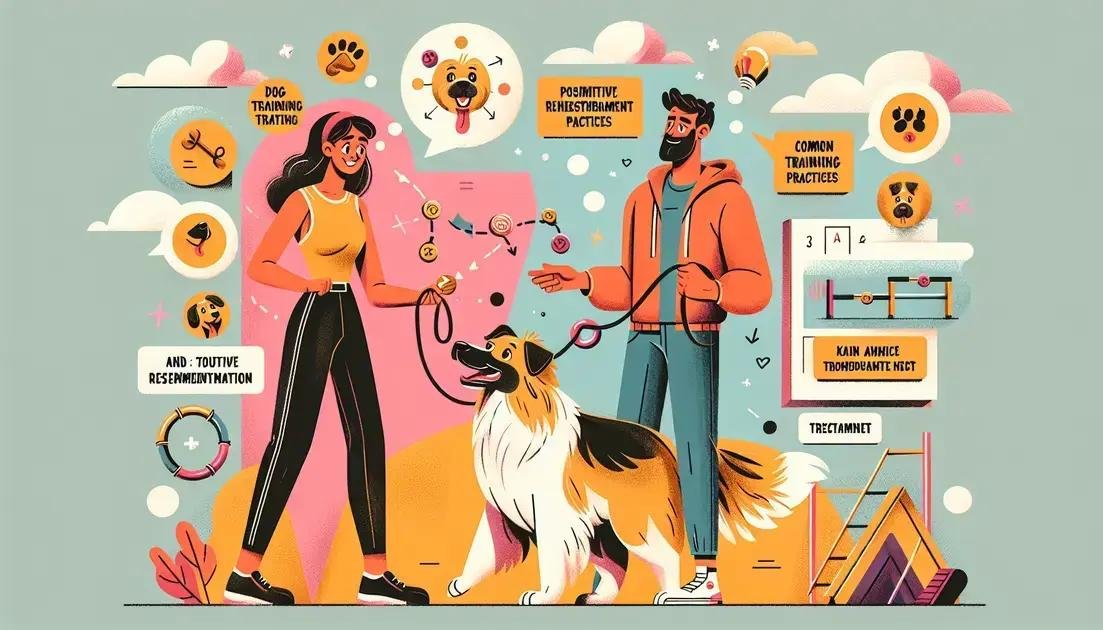Dog training basics are crucial for building a strong bond with your pet and ensuring a well-behaved companion.
With the right approach, you can turn your furry friend into a well-trained and obedient dog.
In this post, we’ll explore the fundamental principles of dog training, including understanding dog behavior, establishing boundaries and consistency, and using positive reinforcement techniques.
Whether you’re a seasoned dog owner or a first-time pet parent, these dog training basics will help you get started on the path to a happier, healthier relationship with your dog.
Understanding Dog Behavior
Understanding dog behavior is a crucial step in dog training. It involves recognizing and responding to your dog’s body language, vocal cues, and behavior patterns.
By understanding what your dog is trying to communicate, you can better anticipate and respond to their needs, reducing stress and anxiety.
Dogs are social animals and thrive on routine, so it’s essential to establish a consistent daily schedule for feeding, exercise, and play.
By doing so, you can help your dog feel secure and develop a sense of trust.
Additionally, recognizing and addressing underlying behavioral issues, such as separation anxiety or fear-based behaviors, can help you build a stronger bond with your dog and improve overall well-being.
Establishing Boundaries and Consistency

Establishing boundaries and consistency is a crucial aspect of dog training. Dogs thrive on routine and predictability, so it’s essential to set clear rules and expectations from the start.
Establish a daily schedule
that includes regular feeding times, exercise, and play. Consistency is key, so make sure all family members are on the same page.
Clear communication and positive reinforcement are essential for reinforcing desired behaviors and discouraging unwanted ones. By establishing a strong foundation of boundaries and consistency, you can build trust and respect with your dog, making training and life with your pet more enjoyable and rewarding.
Positive Reinforcement Techniques
Positive reinforcement techniques are a powerful tool in dog training, as they encourage desired behaviors and strengthen the bond between you and your dog.
When using positive reinforcement, focus on rewarding desired behaviors with treats, praise, and affection, rather than punishing unwanted ones.
Avoid using punishment or negative reinforcement, as this can lead to fear, anxiety, and decreased trust.
Instead, use
high-value rewards
and
clear communication
to reinforce desired behaviors and build a strong foundation for training.
With patience, consistency, and positive reinforcement, you can teach your dog to respond to commands, behave in public, and become a well-behaved and loyal companion.
Common Mistakes to Avoid

In dog training, avoiding common mistakes is crucial to achieving success. One common mistake is failing to establish clear boundaries and consistency, leading to confusion and misbehavior in dogs.
Another mistake is relying too heavily on punishment-based training methods, which can lead to fear and aggression in dogs.
Additionally, failing to reward desired behaviors and ignoring unwanted ones can lead to a lack of motivation and poor behavior.
By avoiding these common mistakes and focusing on positive reinforcement techniques, clear communication, and consistency, you can build a strong foundation for dog training and achieve successful results.
Advanced Training Strategies
Advanced training strategies for dogs involve using a combination of the techniques and principles discussed earlier to achieve more complex behaviors and improve overall training.
One advanced strategy is to use problem-solving exercises to challenge your dog’s mind and build confidence.
Another strategy is to incorporate
obstacle courses
into your training routine to provide mental and physical stimulation.
Additionally, using
real-life scenarios
to train your dog can help them generalize their learning and respond well to distractions.
By incorporating these advanced training strategies into your routine, you can take your dog’s training to the next level and build a stronger bond with your pet.
FAQ – Frequently Asked Questions about Dog Training Basics
What are the most important aspects of dog training?
Understanding dog behavior, establishing boundaries and consistency, using positive reinforcement techniques, avoiding common mistakes, and incorporating advanced training strategies are all crucial aspects of dog training.
How do I establish boundaries and consistency with my dog?
Establishing clear rules and expectations, setting a daily schedule, and using positive reinforcement techniques are all important steps in establishing boundaries and consistency with your dog.
What are some common mistakes to avoid in dog training?
Failing to establish clear boundaries and consistency, relying too heavily on punishment-based training methods, and ignoring unwanted behaviors are all common mistakes to avoid in dog training.
How do I incorporate advanced training strategies into my dog’s training?
Using problem-solving exercises, obstacle courses, and real-life scenarios can help take your dog’s training to the next level and build a stronger bond with your pet.
Why is positive reinforcement important in dog training?
Positive reinforcement encourages desired behaviors and strengthens the bond between you and your dog, making it a crucial aspect of successful dog training.
Can I use artificial intelligence in dog training?
Yes, AI can be used in dog training to analyze data, provide personalized recommendations, and automate repetitive tasks, making it a valuable tool for dog trainers.




